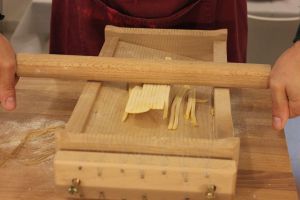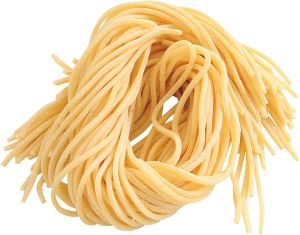Spaghetti Alla Chitarra
The spaghetti alla chitarra, also known as maccheroni alla chitarra, are a variety of egg pasta typical of Abruzzo, Italy. Tonnarelli are a similar pasta from Lazio. They have a square cross section about 2-3 mm thick.
The tool with which this pasta is produced, called the "chitarra" (guitar), gives the pasta its name, shape, and a porous texture that allows pasta sauce to adhere well. The chitarra is a frame with a series of parallel wires crossing it.
The dough consists of durum wheat
semolina,
eggs, and a
pinch of
salt. It is then worked, and after a rest, rolled flat with a
rolling pin. The dough is then placed on the "chitarra" and pushed through with the rolling pin, so that the strings of the guitar cut it into strips. Pasta makers from Abruzzo bring down the cut dough by passing a finger on the pastry, as they would "play an arpeggio". The "chitarra" was invented around 1890 in the province of Chieti. Before that the pasta was cut with a special rolling pin with notches to obtain its particular shape.



In Abruzzo, maccheroni alla chitarra are most typically prepared with a ragout of lamb (ragù d'agnello). In particular areas of the Abruzzi the traditional condiment for this pasta is a tomato sauce with veal meatballs, so-called "pallottelle".
A dried variation without egg is often marketed as spaghetti or maccheroni alla chitarra within and outside of Italy.
Recipe using spaghetti alla chitarra see
Here,
Here and
Here.


